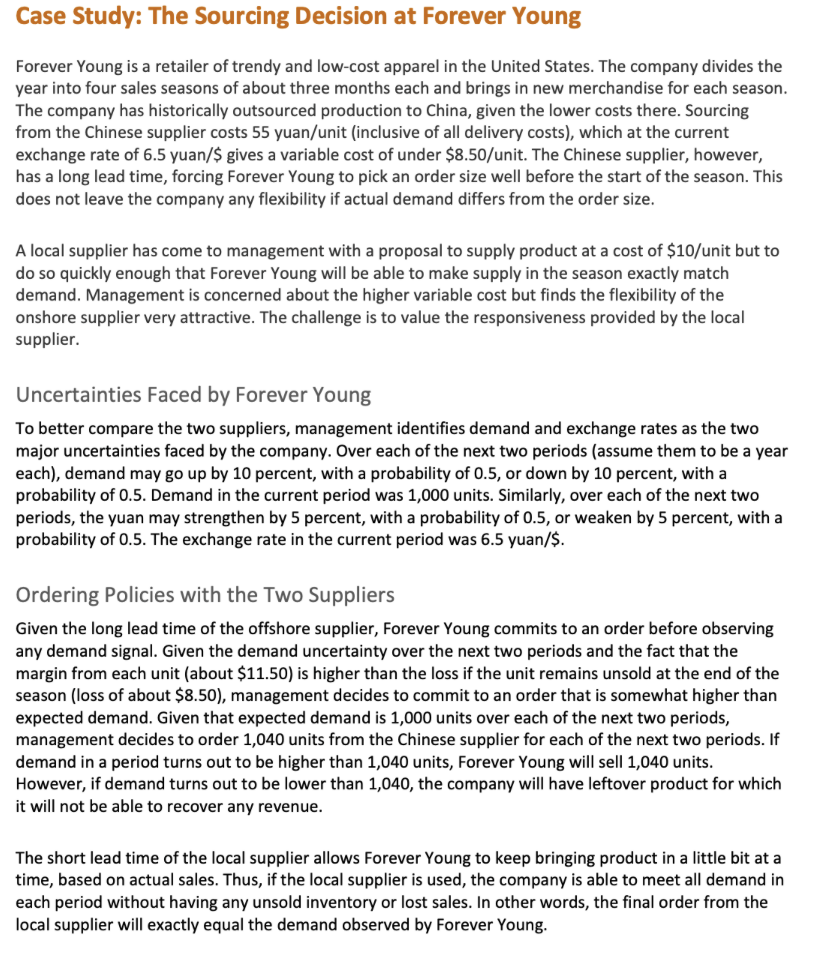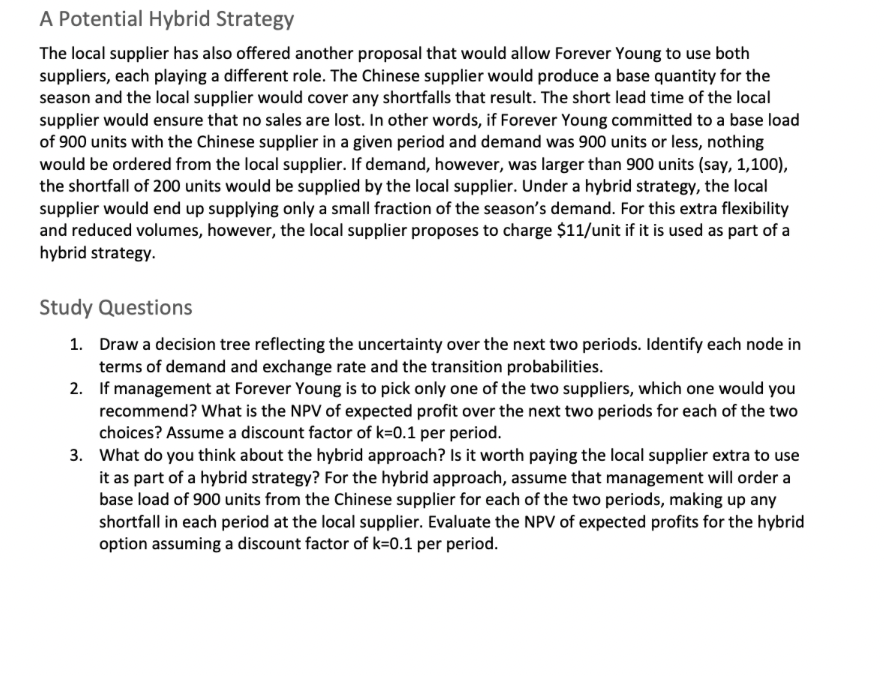Answered step by step
Verified Expert Solution
Question
1 Approved Answer
Case Study: The Sourcing Decision at Forever Young Forever Young is a retailer of trendy and low-cost apparel in the United States. The company


Case Study: The Sourcing Decision at Forever Young Forever Young is a retailer of trendy and low-cost apparel in the United States. The company divides the year into four sales seasons of about three months each and brings in new merchandise for each season. The company has historically outsourced production to China, given the lower costs there. Sourcing from the Chinese supplier costs 55 yuan/unit (inclusive of all delivery costs), which at the current exchange rate of 6.5 yuan/$ gives a variable cost of under $8.50/unit. The Chinese supplier, however, has a long lead time, forcing Forever Young to pick an order size well before the start of the season. This does not leave the company any flexibility if actual demand differs from the order size. A local supplier has come to management with a proposal to supply product at a cost of $10/unit but to do so quickly enough that Forever Young will be able to make supply in the season exactly match demand. Management is concerned about the higher variable cost but finds the flexibility of the onshore supplier very attractive. The challenge is to value the responsiveness provided by the local supplier. Uncertainties Faced by Forever Young To better compare the two suppliers, management identifies demand and exchange rates as the two major uncertainties faced by the company. Over each of the next two periods (assume them to be a year each), demand may go up by 10 percent, with a probability of 0.5, or down by 10 percent, with a probability of 0.5. Demand in the current period was 1,000 units. Similarly, over each of the next two periods, the yuan may strengthen by 5 percent, with a probability of 0.5, or weaken by 5 percent, with a probability of 0.5. The exchange rate in the current period was 6.5 yuan/$. Ordering Policies with the Two Suppliers Given the long lead time of the offshore supplier, Forever Young commits to an order before observing any demand signal. Given the demand uncertainty over the next two periods and the fact that the margin from each unit (about $11.50) is higher than the loss if the unit remains unsold at the end of the season (loss of about $8.50), management decides to commit to an order that is somewhat higher than expected demand. Given that expected demand is 1,000 units over each of the next two periods, management decides to order 1,040 units from the Chinese supplier for each of the next two periods. If demand in a period turns out to be higher than 1,040 units, Forever Young will sell 1,040 units. However, if demand turns out to be lower than 1,040, the company will have leftover product for which it will not be able to recover any revenue. The short lead time of the local supplier allows Forever Young to keep bringing product in a little bit at a time, based on actual sales. Thus, if the local supplier is used, the company is able to meet all demand in each period without having any unsold inventory or lost sales. In other words, the final order from the local supplier will exactly equal the demand observed by Forever Young. A Potential Hybrid Strategy The local supplier has also offered another proposal that would allow Forever Young to use both suppliers, each playing a different role. The Chinese supplier would produce a base quantity for the season and the local supplier would cover any shortfalls that result. The short lead time of the local supplier would ensure that no sales are lost. In other words, if Forever Young committed to a base load of 900 units with the Chinese supplier in a given period and demand was 900 units or less, nothing would be ordered from the local supplier. If demand, however, was larger than 900 units (say, 1,100), the shortfall of 200 units would be supplied by the local supplier. Under a hybrid strategy, the local supplier would end up supplying only a small fraction of the season's demand. For this extra flexibility and reduced volumes, however, the local supplier proposes to charge $11/unit if it is used as part of a hybrid strategy. Study Questions 1. Draw a decision tree reflecting the uncertainty over the next two periods. Identify each node in terms of demand and exchange rate and the transition probabilities. 2. If management at Forever Young is to pick only one of the two suppliers, which one would you recommend? What is the NPV of expected profit over the next two periods for each of the two choices? Assume a discount factor of k=0.1 per period. 3. What do you think about the hybrid approach? Is it worth paying the local supplier extra to use it as part of a hybrid strategy? For the hybrid approach, assume that management will order a base load of 900 units from the Chinese supplier for each of the two periods, making up any shortfall in each period at the local supplier. Evaluate the NPV of expected profits for the hybrid option assuming a discount factor of k=0.1 per period.
Step by Step Solution
There are 3 Steps involved in it
Step: 1

Get Instant Access to Expert-Tailored Solutions
See step-by-step solutions with expert insights and AI powered tools for academic success
Step: 2

Step: 3

Ace Your Homework with AI
Get the answers you need in no time with our AI-driven, step-by-step assistance
Get Started


